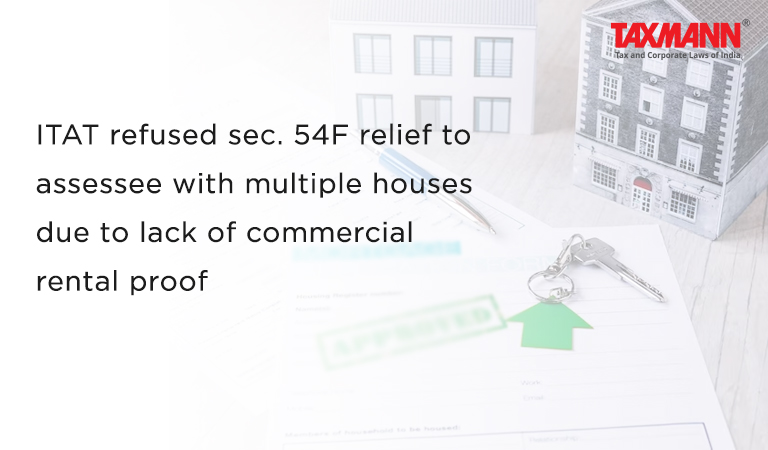ITAT refused sec. 54F relief to assessee with multiple houses due to lack of commercial rental proof
- Blog|News|Income Tax|
- 2 Min Read
- By Taxmann
- |
- Last Updated on 21 March, 2023
Case Details: Surendra Babu Sabbineni v. DCIT - [2023] 147 taxmann.com 560 (Hyderabad-Trib.)
Judiciary and Counsel Details
-
- R. K. Panda, Accountant Member & K Narasimha Chary, Judicial Member
- Kotha Hari Prasad, Adv. for the Appellant.
- Rajendra Kumar, CIT (DR) for the Respondent.
Facts of the Case
Assessee, an individual, filed its return of income for the relevant assessment year. A search operation was conducted, and a revised return of income declaring capital gains was filed. The Assessing Officer (AO) completed the assessment proceedings by allowing the claim under section 54F with respect to such capital gains.
Subsequently, the Principal Commissioner of Income Tax (Pr. CIT) noticed that the assessee owned more than one residential house property at the time of transfer of such capital asset. The AO allowed the deduction claim under section 54F without proper verification of the facts and ordered AO to investigate the case.
Assessee contended that these properties were let out for commercial use and, therefore, did not fall under the purview of a residential unit. Dissatisfied by the assessee’s reply, AO disallowed the deduction claimed under section 54F and computed the income accordingly.
Aggrieved by the order, the assessee preferred an instant appeal to the CIT(A). The CIT(A) confirmed the additions made by AO, and the matter then reached the Hyderabad Tribunal.
ITAT Held
The Tribunal held that there was no merit in the assessee’s contention that all the properties were let out for commercial use and, therefore, did not fall under the purview of a residential unit. As per the details furnished with respect to such properties, although the properties were let out, all these properties are situated in residential societies. The assessee could not prove with evidence that these properties were, in fact, used for commercial purposes.
Further, it was observed that the assessee could not prove that the local authorities were charging taxes on the said properties as applicable to commercial properties. In addition, the assessee furnished no evidence to support the claim that the Electricity Department was charging electricity for the said flats at commercial rates.
Since the evidence was insufficient to support the claim, the CIT(A) rightly upheld order AO disallowing Section 54F’s claim to the assessee.
List of Cases Reviewed
-
- Sanjeev Puri v. Dy. CIT [2016] 72 taxmann.com 147/160 ITD 213 (Delhi) (para 15)
- Naveen Jolly v. ITO [2020] 117 taxmann.com 323/272 Taxman 348/424 ITR 462 (Karn.) (para 15) distinguished.
List of Cases Referred to
-
- Sanjeev Puri v. Dy. CIT [2016] 72 taxmann.com 147/160 ITD 213 (Delhi) (para 10)
- Naveen Jolly v. ITO [2020] 117 taxmann.com 323/272 Taxman 348/424 ITR 462 (Karn.) (para 10).
Disclaimer: The content/information published on the website is only for general information of the user and shall not be construed as legal advice. While the Taxmann has exercised reasonable efforts to ensure the veracity of information/content published, Taxmann shall be under no liability in any manner whatsoever for incorrect information, if any.

Taxmann Publications has a dedicated in-house Research & Editorial Team. This team consists of a team of Chartered Accountants, Company Secretaries, and Lawyers. This team works under the guidance and supervision of editor-in-chief Mr Rakesh Bhargava.
The Research and Editorial Team is responsible for developing reliable and accurate content for the readers. The team follows the six-sigma approach to achieve the benchmark of zero error in its publications and research platforms. The team ensures that the following publication guidelines are thoroughly followed while developing the content:
- The statutory material is obtained only from the authorized and reliable sources
- All the latest developments in the judicial and legislative fields are covered
- Prepare the analytical write-ups on current, controversial, and important issues to help the readers to understand the concept and its implications
- Every content published by Taxmann is complete, accurate and lucid
- All evidence-based statements are supported with proper reference to Section, Circular No., Notification No. or citations
- The golden rules of grammar, style and consistency are thoroughly followed
- Font and size that’s easy to read and remain consistent across all imprint and digital publications are applied








 CA | CS | CMA
CA | CS | CMA


